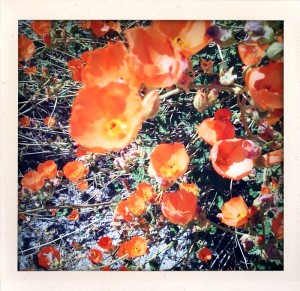
This is going to sound odd, but I’m pretty sure I’m being stalked…by citizen science.
Ever since we launched Science for Citizens a few months ago, I find myself bumping into science and taking part in science-flavored activities no matter where I am or what I’m doing.
Take my recent trip to California’s Anza Borrego Desert State Park. My wife, Susan, and I spent five days hiking the trails and ogling the dramatic mountains surrounding the desert valley. And everywhere we turned, there it was: science—for citizens. (Cue the sneaky shark theme from “Jaws.”)
Item: Borrego Springs, the location of the park’s visitor’s center as well as our hotel, just happens to be the first town in California to be designated a “dark sky community.” (Who knew?) To keep the stars visible in the local sky, the town limits the number of street lights and requires that they all shine downward only. Guess what? There’s a citizen science project for that. It’s called Globe at Night and it enlists volunteers to record their observations of particular constellations in order to measure light pollution and raise awareness about the issue all over the world.
Item: We also just happened to be in this dark-sky Mecca at the very peak of the annual Lyrids meteor shower. Spending the wee hours of one morning sitting on a rock and staring up, I was rewarded with the sight of a meteoric torch dropping from the eastern sky. Not your typical now-you-see-it/now-you-don’t streaker, mind you, but a surreal, slow-motion, flickering flame-out of some interplanetary debris. It must have lasted five seconds. Quite a coincidence. Or was it?
Item: Turns out the desert was having another peak, this one during daylight hours. On our hikes, we were treated to the wildflower explosion that redecorates this tough terrain every year. We consulted our guidebooks to learn the names of the blossoms, and then we remembered—there’s a project for this, too: Project Budburst, which coordinates citizen naturalists’ observations of the season’s “first flowerings” and passes them along to scientists studying climate and the environment.

Item: We couldn’t help but become amateur experts of desert wildlife as well. Plump chuckwalla lizards skittered across our paths, rust-colored dragon flies buzzed about, and don’t get me started on the birds.
Oh, all right, one bird story: We’re standing in front of a Mesquite tree on a self-guided nature trail, reading about how this tree is often tangled up with clumps of Desert Mistletoe, the berries of which are the favorites of a bird known as Phainopepla. Though I admit to long-standing science geek tendencies, for some reason I’ve never gotten into birding, and making a new feathered friend in the wild has always seemed beyond my abilities—especially any friend with a name like Phainopepla. But as soon as we see this explanation in our pamphlet, as if on cue a pair of these birds flit in from nowhere and settle into the clot of Mistletoe in the Mesquite in front of us. Freaky. I remark that the male is a handsome, dark-gray cardinal look-alike—and all of a sudden, here’s me turning into a birder.
And yes, there’s a project for that. Back at the hotel, Susan and I couldn’t fight the compulsion to jump on the Wi-Fi and set up our very first online birding checklist at eBird. Now I’m not only the stalkee, I’m also a stalker. (Of birds, but still.)
Item: One afternoon we stopped by the park store operated by the Anza Borrego Institute and mentioned that we’ve started up this new website for citizen scientists. Whereupon, Kelley Jorgensen, the friendly “interpretive sales manager” ticked off about half a dozen projects that the Institute sponsors in wildlife monitoring. Like the elusive bighorn sheep that dwell in the nearby desert canyons, quiet and well-camouflaged, these projects had been close, very close, but we never saw them. (Speaking of bighorns, Kelley also told us that the Institute is recruiting volunteers for the up-close and personal count of these amazing animals that takes place every July. We’ll soon be adding all these activities to our Project Finder.)

Even after we left the desert, there was no escape from the stalking. On the drive back to Northern California, Susan pointed out an unexpected road sign—”Mount Palomar Observatory: 8 miles”—and we were drawn irresistibly to yet another dose of science serendipity. On the very afternoon that we took this seemingly unplanned detour up the snow-lined mountain road, this legendary source of countless astronomical wonders—this “glass giant” that I read about with great reverence as a moon-shot-addled, astronaut-wannabe adolescent—was offering tours to the public!
We spent an hour inside the dome, hearing tales of the huge telescope’s heroic construction, getting a recap of its mind-expanding discoveries. I felt I had died and gone to citizen astronomer’s heaven. It was…what? Cosmic kismet? It was almost too much. (I do look a little goofy with enthusiasm in that picture, don’t I?)
Don’t get me wrong. I’m not complaining about being stalked like this. It’s weird, but it’s also wonderful. Every time it happens, the scientific factoid I pick up, the jolt of wonder that hits me, or the sense that my humble actions might contribute to a slightly better understanding of one corner of the neighborhood, planet, or universe—well, that’s amazing, isn’t it?
Wherever you are, whatever you’re doing, something scientific is lurking close by. Here at Science for Citizens, we think it’s a far more interesting and worthwhile world when you’re aware of and engaged with the science that permeates it.
What about you? Have you noticed that citizen science is following you around? And what are you going to do about it?

